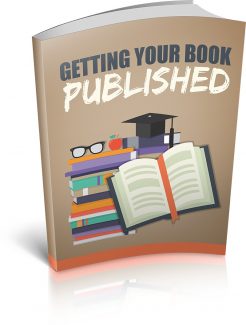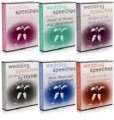 License Type: Master Resell Rights
License Type: Master Resell Rights  File Type: ZIP
File Type: ZIP
 SKU: 62279
SKU: 62279  Shipping: Online Download
Shipping: Online Download
Sample Content Preview
INTRODUCTION
The publishing industry remained virtually unchanged for decades in terms of how books are published. The writer would write a fiction or nonfiction book, hire an agent, select a publisher, and eventually a book would be printed. Of course, printing and marketing a book are two entirely different things. The point is that once the printing process was developed, books were destined to be printed for hundreds of years on paper.
The printed book still remains the most common and popular method of publishing. Five-hundred thousand or more new titles are published every year. But there is an emerging trend that is expected to eventually change the world of publishing. Electronic books available online that can be downloaded to special readers or desktop computers are becoming more and more popular. In fact what people seem to be waiting for before this form of publishing explodes is a more comfortable reader, more available titles, and time to adjust to the idea of pages that are electronic rather than printed.
When you talk to people about books, many get a faraway look in their eyes. They are thinking of those wonderful moments before going to sleep with a book in their hands. They are remembering those golden moments when the day’s struggles and worries are over and it’s time to get lost in another world contained in the pages. This may seem like a romantic view of the books, but people who enjoy reading talk about the feel of the book’s page in their hands and the words that can convey emotions, actions, concepts, failures, and successes.
And for every person that loves to read there is most likely someone who wants to publish a book. There are millions of people who have a story inside of them but are afraid to tackle the world of book publishing. How do you compete with the likes of Stephen King, Barbara Kingsolver, Kathy Reichs, or any of the hundreds of other popular authors whose books have prominent places on bookstore shelves?
There is a way. The publishing industry is always looking for new authors that can appeal to both mass audiences and to niche markets. You don’t have to be the next Edgar Allen Poe or Sandra Brown to become a published author. You can simply be…you. Almost everyone seems to have a book “in them” but what separates the real author from the wouldbe author is first writing the book and second finding a way to get it published.
If you have a passion to write a book then you need a passion to get it published. Today there are two main choices: traditional books printed on paper and electronic books. Within the electronic book publishing industry there are even more options including eBooks, print-on-demand books, and books that can be downloaded to a special portable reader.
In the following sections the process of getting a book published is reviewed. There will be a discussion about the writing process, finding an agent, choosing a publisher, working with an editor, and marketing the book. There is also a section on electronic publishing using Amazon as an example of industry trends. Book publishing has never been more accessible to potential authors then it is today. That is good news for anyone who is ready to publish!
OVERVIEW OF THE PUBLISHING INDUSTRY
As mentioned, the publishing industry offers several options for getting your book published.
TRADITIONAL PRINT PUBLISHERS
The traditional print publisher prints a book on pages, adds a cover, binds the pages, and then reproduces it in as many copies as believed to be sellable. But first you have to get your book to the publisher before any of this can happen. That can happen in one of two ways.
- Submit to an editor who works for a publisher
- Submit directly to the publisher
In the chapter titled All About Publishers there is a lengthy discussion about publisher and the selection process.
SELF PUBLISHING
Self-publishing is exactly what it sounds like: you take most or all of the responsibility for printing, cover design, binding, reproduction, marketing, and distribution of the book. You can self-publish a printed book or you can self-publish an electronic version of your book or you can choose a print-on-demand option. Some authors choose to publish both print and electronic versions of their book in the hopes of selling more books. When you do everything yourself, you also assume all the up-front expenses. That is why there has been growth in the businesses that assist self-publishers. One of the fastest growing self-publishing areas is electronic publishing. Even sellers of print books, like Amazon, have added self-publishing units that give authors a forum for getting their books into the marketplace.
ELECTRONIC PUBLISHING
Electronic publishing is considered to be the wave of the future in the opinion of some experts. There are several options to choose among.
- Use a commercial e-publisher to publish, market, sell, and distribute an electronic book
- Set up a print-on-demand version of your book where you can order small quantities of your electronically formatted book to be paper printed as needed
- Set up your own website and publish and sell your book
- Use an online bookseller like Amazon to publish and sell your book
- Self publish your book but use an online bookseller like Amazon to promote and sell your book
As you can see there are a number of ways to get your book electronically published. Electronic books can be downloaded and printed, downloaded to a special handheld reader, or read online.
GETTING STARTED
With so many great options available today in the publishing industry, it’s easy to get confused. It is important to keep in mind that most of the publishing concepts are the same. Many of principles behind the writing process, editing, finding a publisher, and marketing apply whether you are talking about a traditional print book or an electronically published book. The principles are the same but the process may differ. For example, marketing principles underlay the strategies for selling a book but the actual tactics can differ if the book is only available electronically. In the following sections the principles that are discussed assume a book is being published in print form. In the chapter Self Publishing and Electronic Publishing the process for publishing and marketing eBooks and other electronic book versions are reviewed.
THE WRITING PROCESS – AN OVERVIEW
This is an eBook about publishing and not about writing per se, but you will have a much greater chance of getting your book published if you choose your idea carefully and keep your ultimate goals in mind. Your idea should not be strictly driven by the desire to get published, but you also do not want to write a book that only five people will read. For most writers coming with the desire to be published is the desire to make some money too. As you will learn later the amount of money you will make will be dependent on the number of books you sell and the negotiated contract.
FINDING IDEAS
So where do you get ideas for a book? The answer is you get them everywhere! If you want to know what sells and what people are interested in reading, you can start with a visit to the bookstore. Just simply visit a neighborhood bookstore and look at the prominent displays. What are the tables displaying? What types of books are present in the largest quantities?
With the internet it is also easy to search for lists of the most popular books that are selling. Bestseller lists provide a quick view of the book market and what the public is reading. There are even lists by type of book. If you are determined to write a nonfiction book then look at the nonfiction bestseller lists.








